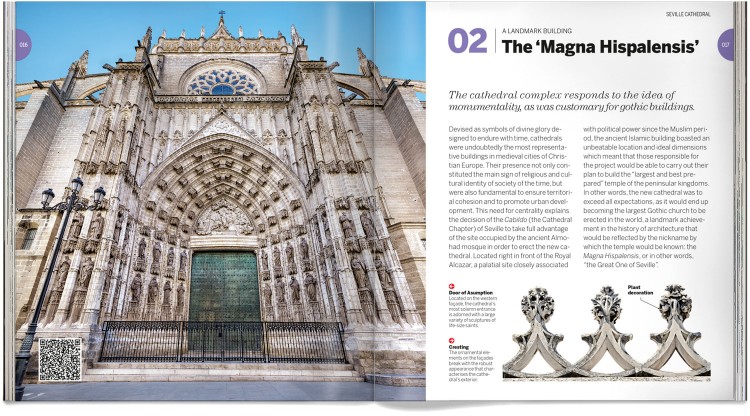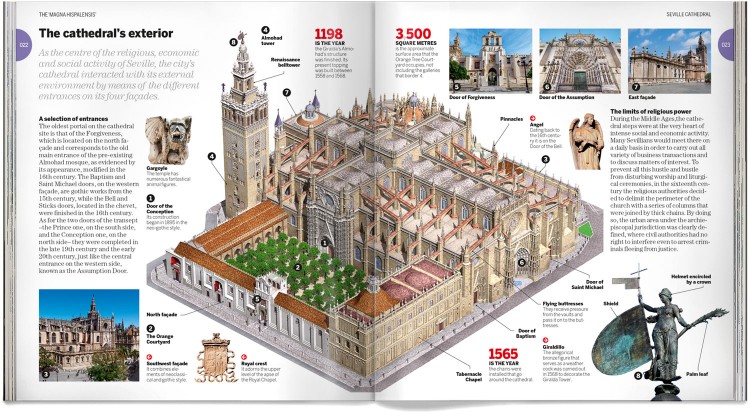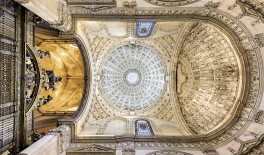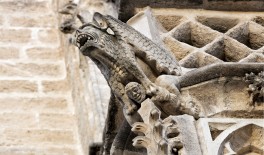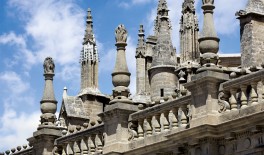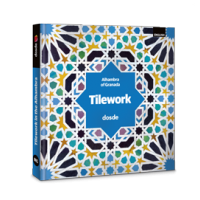Seville Cathedral
The cathedral of Saint Mary of the See
About the book Seville Cathedral
This book published by Dosde is an indepth look, by means of texts, photographs and illustrations, at the history of the Cathedral of Seville and the peculiarities of its architecture. Declared a World heritage Site by Unesco, the cathedral is one of the most admired architectural ensembles in the world.
Included within the Architecture Series, this book about Seville Cathedral has been published in Visual Edition, a format characterised by its abundance of photographs and detailed didactic information, making it entertaining reading whilst at the same time providing the reader with a global vision of the subject. In this series there are other books available such as the book on Santiago cathedral.
The pages of this book on Seville Cathedral provide us with a detailed look at an absolute icon of religious architecture. With its more than 400 photographs, drawings and 3D illustrations, the reader can find out all there is to know about the cathedral, discover its stained glass windows, the sculptural decoration and get to know the different architectonic styles within. It is one of the most comprehensive books published to date on the Cathedral of Saint Mary of the See.
The city of Seville's architectonic wealth and its priceless monuments are all gathered together in the books on Seville published by Dosde.
Visual Edition
Seville Cathedral
It includes exclusive digital content
Official licensed product
Made with environmentally friendly paper
Multilanguage: Available in 6 languages
About the book Seville Cathedral
This book published by Dosde is an indepth look, by means of texts, photographs and illustrations, at the history of the Cathedral of Seville and the peculiarities of its architecture. Declared a World heritage Site by Unesco, the cathedral is one of the most admired architectural ensembles in the world.
Included within the Architecture Series, this book about Seville Cathedral has been published in Visual Edition, a format characterised by its abundance of photographs and detailed didactic information, making it entertaining reading whilst at the same time providing the reader with a global vision of the subject. In this series there are other books available such as the book on Santiago cathedral.
The pages of this book on Seville Cathedral provide us with a detailed look at an absolute icon of religious architecture. With its more than 400 photographs, drawings and 3D illustrations, the reader can find out all there is to know about the cathedral, discover its stained glass windows, the sculptural decoration and get to know the different architectonic styles within. It is one of the most comprehensive books published to date on the Cathedral of Saint Mary of the See.
The city of Seville's architectonic wealth and its priceless monuments are all gathered together in the books on Seville published by Dosde.
Additional Information
- Additional Information
- Subtitle: The cathedral of Saint Mary of the See
- Weight (g): 425
- Binding: Paperback with flaps
- Size (cm): 17,5 x 19,5
- Author: Dosde
- Pages: 0
- Edition: Visual Edition
When was Seville Cathedral built?
The foundations of the exterior perimeter of the old Almohad mosque determined the design of the Gothic cathedral, which took just over seven decades to build. In the year 1248 the Christianization of the mosque took place. In order to adapt the old Almohad building to Christian worship, its orientation was modified and diverse chapels were built.
It wasn't until 1433 that construction work actually commenced, which was carried out at the same time as they pulled down the Almohad structure. Much later on, in 1506, the cimborrio’s keystone was put into place and the cathedral was deemed finished. However, in 1511 the dome caved in due to a structural fault, which meant that a new, smaller cimborrio had to erected.
What to see in Seville Cathedral
In addition to its extraordinary dimensions, Seville Cathedral has a rather unusual structure for gothic architecture, due to the vicissitudes surrounding its construction, making it an atypical project.Seville Cathedral's oldest door is the Forgiveness one, which is located on the north façade and corresponds to the old main entrance of the former Almohad mosque, as evidenced by its appearance, modified in the 16th century.
The side overlooking the Avenida de la Constitución holds the entrance to the Church of the Tabernacle and the cathedral’s main façade, consisting of three portals that correspond to the central and lateral naves. On the main façade there is special attention paid to the monumental sculptures dedicated to major figures in the Christian world.
La Giralda, the belltower on the northeast corner of the cathedral was the Almohad mosque’s minaret, which was renovated in the Christian era. Just as explained in numerous books on architecture, the Giralda has converted into the main architectonic symbol of Seville.
The inside of Seville Cathedral
The interior of the cathedral is organised in an unconventional way. While in the medieval cathedrals of the Iberian Peninsula the Latin cross ground plan with four naves was the prevailing style, in order to devise Seville Cathedral the rectangular floor of the old mosque was divided up into five longitudinal naves with nine sections, to which were added rows of chapels on the sides.The main chapel, which is delimited by three golden iron Renaissance grilles, is the space that constitutes the symbolic epicenter of the cathedral. It boasts the largest altarpiece in the Christian world, a piece of polychromed wood measuring 28 metres high by 18 metre wide adorned with biblical scenes that is unparalleled in the history of art. The altarpiece is crowned by a figure from the 14th century known as Cristo del Millón for the numerous favours and miracles attributed to him.
The choir is one of the most striking parts of Seville Cathedral. Presided by a large lectern, the two sections of the central nave reserved for the canons to pray have 117 seats of honour carved in wood between the fifteenth and sixteenth century.
The seating arrangement is divided into two levels and is decorated with Gothic carvings that address religious and secular themes. On the outside, the wall going around the choir stalls is lavishly decorated. It is built with different coloured marble and jasper, and presided by the image of the Virgin of the Remedies.
In the transept’s north arm is the silver altar, a work created to exalt the eucharistic rite, and it is still considered a benchmark in baroque Seville silversmithing. The transept's south arm was the place chosen by the council to hold the tomb with the remains of Christopher Columbus, brought to Seville from Cuba in 1899.
The stained glass is also one of the most breathtaking attractions of Seville Cathedral. Devised as an important part of the temple, the stained glass makes up one of the most important ensembles in the world, both for its scope and its symbolism.
The iconographic scheme of the stained glass decorating the cathedral focuses on the representations of prophets, apostles, saints and fathers of the Church, though it also includes cycles dedicated to the lives of Jesus Christ and the Virgin Mary, inspired by some of the best-known passages in the Gospels.
The chapels of Seville Cathedral
The temple houses many chapels that combine the worship of saints and virgins with a funerary function. Amongst them is the royal chapel of Seville Cathedral, the Renaissance-style structure in the cathedral's chevet holds the remains of Ferdinand III and other members of the Castilian royal family.Completed by Hernán Ruiz in 1569, the building has a quadrangular ground plan, with a presbytery that is attached to the east side and two lateral chapels of rectangular design with galleries open to the main space, which was covered by a semi-circular dome equipped with a small tower.
The dome is divided up into quadrangular coffers in which various busts of kings were incorporated, whose size gradually increases in accordance with their height.
At present, Seville Cathedral is one of the main Christian temples of reference, visited by tens of thousands of people every year. Converted into one of the symbols of the Andalusian city, the cathedral responds to the idea of monumentality, as was customary for gothic style buildings.

